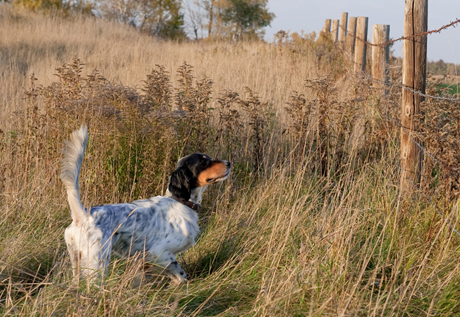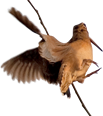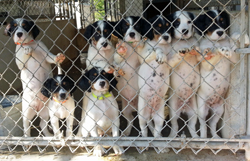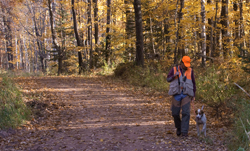Scenting ability

Northwoods Parmigiano shows lofty style and precise bird location on point along a fence row.
The ability to find game is directly related to the scenting powers of the dog. It’s the most important natural quality. You can train a dog to come when called, point, back and retrieve but you can’t teach a dog to have a better nose.
There are a lot of dogs with a good nose and occasionally one with what may be called a “superb” nose. Of course, such a dog is a rarity.
~Er M. Shelley, 1921
Shelley was a bird dog trainer in the early 20th century. He also spent five years in Africa hunting lions and leopards with hounds and game dogs and knew about scenting ability. The hounds were hunted in packs of 20 to 30 and comparisons were simple. It was easy to determine which dogs had the best noses.
Often though, it’s difficult to differentiate between a good nose and a great one unless dogs are hunted in pairs. Too, one outing doesn’t prove anything. But if, over a period of time, certain dogs just find more birds than their bracemates, it’s logical to conclude that they have better noses.
The dog that points his birds with exact location, always going to them at a fast pace with his head up into the wind and getting as close as possible to the birds without flushing them, indicates that he has the better nose.
~ Earl C. Crangle, 2000
Some think a dog that points from the farthest distance has the best nose. I agree with Crangle. It’s just the opposite. The dog with the best nose points its birds as close as possible without flushing them. This dog smells the birds from afar but discerns the distance and then pinpoints their locations.
To be most useful, the scenting ability should work with the rate of speed at which the dog hunts. The faster the dog hunts, the better its scenting should be. In other words, I’d always prefer a 5 mph dog with a 10 mph nose. This also explains why, as some young dogs mature, they begin to find more birds. They finally hunt at a pace that allows their noses to work out ahead of them.
Another common belief is that certain weather conditions affect a dog’s scenting ability. Actually, bird movement, or lack thereof, is the culprit. Studies of radio-marked bobwhite quail show that high winds, high temperatures, low humidity, rain and the proverbial east wind cause quail to be less active.
Hard-core dog people and serious bird hunters know which end of the dog points the birds. They will always choose to live with other, perhaps minor faults in their dog if it has exceptional scenting ability.




